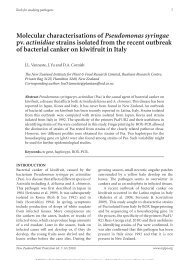field assessment of herbicides to release native plants from weeds
field assessment of herbicides to release native plants from weeds
field assessment of herbicides to release native plants from weeds
Create successful ePaper yourself
Turn your PDF publications into a flip-book with our unique Google optimized e-Paper software.
Weeds <strong>of</strong> the Natural Environment 369<br />
included perennial ryegrass (Lolium perenne), brown<strong>to</strong>p (Agrostis capillaris), Yorkshire<br />
fog (Holcus lanatus), white clover (Trifolium repens) and sweet vernal (Anthoxanthum<br />
odoratum), and no control <strong>of</strong> this vegetation occurred at planting.<br />
TABLE 1: The species tested for herbicide <strong>to</strong>lerance, with average age (months)<br />
and height (cm) <strong>of</strong> the <strong>plants</strong> when treated.<br />
Common name Botanical name Family name Age (months) Height (cm)<br />
koromiko Hebe stricta Plantaginaceae 6 50-60<br />
manuka Lep<strong>to</strong>spermum scoparium Myrtaceae 4 30-40<br />
mountain flax Phormium cookianum Agavaceae 16 35-45<br />
purei Carex secta Cyperaceae 4 25-35<br />
ribbonwood Plagianthus regius Malvaceae 16 80-90<br />
<strong>to</strong>e<strong>to</strong>e Cortaderia fulvida Poaceae 16 80-100<br />
On 9 Oc<strong>to</strong>ber 2007, once the <strong>plants</strong> appeared <strong>to</strong> have recovered <strong>from</strong> the transplanting<br />
process, herbicide treatments were applied around the <strong>native</strong> <strong>plants</strong> <strong>to</strong> <strong>release</strong> them <strong>from</strong><br />
the competition being exerted by the surrounding vegetation. Herbicides were applied<br />
using a 15 litre Solo back-pack sprayer with a flat-fan nozzle, applying herbicide solution<br />
by moving the nozzle around each plant within an 80-cm-diameter ring for a period <strong>of</strong><br />
7.0 s, equating <strong>to</strong> 50 ml <strong>of</strong> spray solution <strong>to</strong> 0.5 m 2 and thus 1000 litres/ha. Vegetation<br />
surrounding each plant was thoroughly covered in spray, and the lower parts <strong>of</strong> each<br />
<strong>native</strong> plant also received the herbicide.<br />
The <strong>herbicides</strong> used are shown in Table 2, while treatments applied around each <strong>native</strong><br />
plant species are listed in Table 3. Note that not all herbicide combinations were applied<br />
<strong>to</strong> all species because results obtained by Harring<strong>to</strong>n & Schmitz (2007) indicated some<br />
treatments would be damaging and thus were not worth repeating. For the one grass<br />
species in the trial (<strong>to</strong>e<strong>to</strong>e), many <strong>of</strong> the treatments used on other species were not used<br />
as they included haloxyfop, a herbicide known <strong>to</strong> damage grasses. Instead, a number<br />
<strong>of</strong> treatments were assessed for selective control <strong>of</strong> grass <strong>weeds</strong> around the <strong>to</strong>e<strong>to</strong>e. If<br />
a herbicide treatment was not assessed on a species, the corresponding space within<br />
Table 3 is blank. All treatments were compared with unsprayed controls for each plant<br />
species, and also with a treatment in which glyphosate was applied <strong>to</strong> surrounding<br />
vegetation using a half-bucket <strong>to</strong> shield the <strong>native</strong> plant <strong>to</strong> give a weed-free comparison.<br />
In addition, ribbonwood received dichlobenil in the form <strong>of</strong> granules applied directly<br />
<strong>to</strong> the ground around the <strong>plants</strong>.<br />
The weather was fine on the day <strong>of</strong> herbicide application, with air temperatures reaching<br />
a maximum <strong>of</strong> 16.5°C and an overnight low <strong>of</strong> 9.5°C, while the soil temperature was<br />
11.2°C at 10 cm. There was 4.6 mm <strong>of</strong> rain the following day, and 29.4 mm over the<br />
next 7 days.<br />
The trial design was a separate randomised block design for each <strong>native</strong> species,<br />
replicated four times, with blocking done based on scores <strong>of</strong> <strong>native</strong> plant health the<br />
day prior <strong>to</strong> spraying. The health <strong>of</strong> both the <strong>native</strong> <strong>plants</strong> and the sprayed vegetation<br />
were scored at regular intervals in the weeks after treatment. For the <strong>native</strong> <strong>plants</strong>, the<br />
scoring system ranged <strong>from</strong> 0 for no effect <strong>of</strong> <strong>herbicides</strong> (and no competition on the<br />
<strong>native</strong> <strong>plants</strong>) through <strong>to</strong> 10 for <strong>to</strong>tal death due <strong>to</strong> <strong>herbicides</strong> and/or weed competition.<br />
For the <strong>weeds</strong> growing in the treated zone around each weed, a score <strong>of</strong> 0 was given<br />
if the vegetation appeared no different <strong>to</strong> elsewhere in the paddock that had not been<br />
sprayed, and a score <strong>of</strong> 10 was given where the soil in the treated zone was completely<br />
bare <strong>of</strong> live vegetation other than the <strong>native</strong> plant. Grasses and broad-leaved <strong>weeds</strong> were<br />
bulked <strong>to</strong>gether for this weed score, but frequent notes were also taken <strong>of</strong> which species<br />
were dominating for each <strong>of</strong> the herbicide treatments. Data for <strong>native</strong> plant health were<br />
© 2009 New Zealand Plant Protection Society (Inc.) www.nzpps.org Refer <strong>to</strong> http://www.nzpps.org/terms_<strong>of</strong>_use.html




